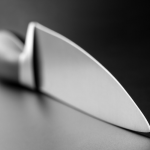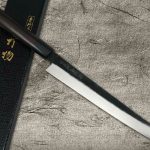img by : hocho-knife.com
If you’re a Japanese food lover, a sushi addict, a die-hard fan of squishy, yet luxurious vivid-colored Caviar beads, and someone who asks for Miso soup at a restaurant without realizing you’re not at a Japanese restaurant, then you’re definitely a huge fan of Japanese cuisine. If you’re into Japanese animation – basically having merchandise and even tickets to exhibitions and shows, you will often be referred to as an ‘Otaku’. However, in the culinary sense, if one is seriously addicted to certain flavors, the divine tastes and scents of fresh, caught-from-sea raw fish and delicious seafood, then that makes you a fantastic eater and a cordon bleu – always craving for delicious, mouth-watering food.
Japanese delicacies like sushi and sashimi are often regarded as clean dishes, healthy for all diners and gourmets in general. As fine selections of raw fish like Salmon, Sea Bass, Mackerel, Fatty Tuna, and fresh seafood like squid, prawn, and oyster provide all the nutrients the body needs to keep one physically healthy. Sushi is also known as Japan’s ‘convenient food’ as it appears to be in marts, convenient stores, and sushi stalls. However, the real authentic sushi cooked in traditional Japanese restaurants and luxurious, grand Omakase restaurants are just completely ‘different’. As for sashimi dishes, most are found at sushi restaurants and specialty restaurants only, and are not available at convenient stores at all.
Sashimi dishes require a lot of attention and careful, intricate cooking and preparation processes that are much more complicated than those of sushi (some dishes). As sushi is served along with beautifully formed Japanese rice mixed with vinegar, salt, and sugar, sashimi is different – only fresh, raw fish slices are served alongside sides, depending on what you’re having.
These two Japanese delicacies have been popular and famous among Japanese food lovers for ages, as the delicate flavors of raw fish blends with creative combinations of tastes that come from the authentic Japanese liquid condiments like Shoyu and soy sauce, along with the unique spice from Wasabi paste. Diners from all parts of the world enjoy sushi and sashimi, as they are healthier choices of diet and are delicious. However, another reason why these Japanese delicacies are devoured and enjoyed in various destinations is also due to the beauty of ‘crafting’ them.
Japanese cuisine is known for its delicate food preparation process – along with the latter comes the Japanese food aesthetics everyone enjoys. Food placement, plate decoration, and a combination of varying, fine-selected ingredients make Japanese food such a unique, hand-crafted culinary artwork. Japanese chefs are always in the search for top-tier quality Japanese knives to work with, and most of all, trusted Japanese knife brands which provide users high-end, premium-quality blades.
Yu Kurosaki’s Senko EI WA RS8H Nakiri Knife
Among Japan’s top quality knife brands, Yu Kurosaki tops the charts for its unique blade designs, extreme blade sharpness, excellent edge retention, superb rust and stain resistance, and reasonable prices. Yu Kurosaki and his crew consists of highly-skilled craftsmen, where this special EI series feature razor-sharp knife edges – the shiny area of the blade has an original hammered texture which represents firecrackers or ‘SENKO’ in Japanese. This Nakiri knife is crafted out of the Super Gold 2 micro carbide powder stainless steel, which is among the world’s hardest steels – offering the blade’s capability to be wear-resistant and durable for long-term uses.
As this Yu Kurosaki R2(SG2) Hammered SENKO-EI WA RS8H Japanese Chef’s Nakiri (Vegetable) Knife 165mm with Brown-Ring Octagonal Handle is good at cutting, chopping, and even slicing vegetables of most kinds, it is highly recommended by head chefs for professional use.



